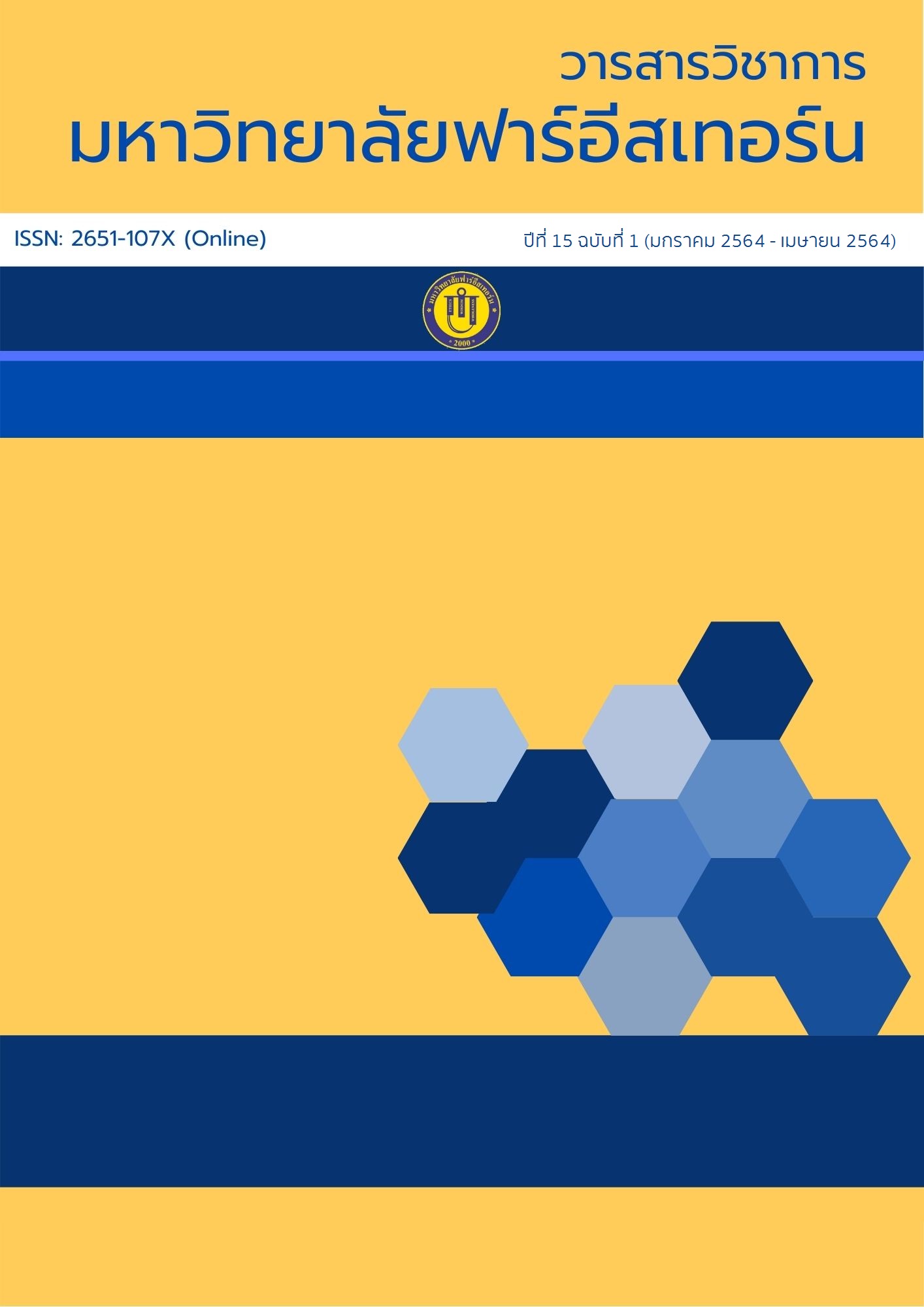ความต้องการในการพัฒนาทักษะการสื่อสารอวัจนภาษาของพนักงานโฮมสเตย์ชาวไทยในบริบทการท่องเที่ยววิถีใหม่ จังหวัดเชียงใหม่
Main Article Content
บทคัดย่อ
งานวิจัยนี้ศึกษาความต้องการในการพัฒนาทักษะการสื่อสารอวัจนภาษาของพนักงานโฮมสเตย์
เพื่อให้บริการนักท่องเที่ยวชาวต่างชาติ ในบริบทการท่องเที่ยววิถีใหม่ การวิจัยเชิงผสมวิธีนี้ประกอบด้วย 2 ระยะ ระยะที่ 1 การศึกษาเบื้องต้นจากการสังเกตการณ์และการสัมภาษณ์เกี่ยวกับความต้องการในการพัฒนาทักษะการสื่อสารภาษาอังกฤษของผู้ประกอบการและพนักงานโฮมสเตย์ จำนวน 8 คน ในตำบลแม่นะ อำเภอเชียงดาว และระยะที่ 2 การสำรวจความต้องการในการพัฒนาทักษะการสื่อสารอวัจนภาษาของพนักงานโฮมสเตย์ในจังหวัดเชียงใหม่ จำนวน 15 คน โดยใช้แบบสอบถามมาตราส่วนประมาณค่า 5 ระดับ เกี่ยวกับความสำคัญของอวัจนภาษา ความถี่ในการสื่อสารอวัจนภาษาและปัญหาการสื่อสารในโฮมสเตย์ ผลการวิจัยพบว่าการสื่อสารอวัจนภาษามีความสำคัญในการแสดงความรู้สึกและเพิ่มประสิทธิภาพในการสื่อสารกับชาวต่างชาติ การสื่อสารอวัจนภาษาที่พบบ่อยที่สุด คือท่าทาง การสบตา และสัญลักษณ์มือ นอกจากนี้การสื่อสารในธุรกิจโฮมสเตย์ที่ท้าทายมากที่สุด คือ การขอความร่วมมือในการรักษาระยะห่าง การพูดคุยเกี่ยวกับการบริการรถรับส่งและการแนะนำสุขอนามัยที่เหมาะสม ข้อแนะนำในการพัฒนาสื่อสารอวัจนภาษาของพนักงานโฮมสเตย์ ได้แก่ เพิ่มความตระหนักและความเข้าใจในการสื่อสารอวัจนภาษาของประเทศต่างๆ ฝึกใช้อวัจนภาษาควบคู่กับคำและสำนวนภาษาอังกฤษ คำอ่านและการแปลความหมายภาษาไทย ตลอดจนเรียนรู้จากสื่อรูปภาพสัญลักษณ์เพื่อเพิ่มความเข้าใจในการสื่อสารอวัจนภาษา
Article Details
1. ทัศนะและข้อคิดเห็นใดๆ ในวารสารนวัตกรรมสังคมและการเรียนรู้ตลอดชีวิตเป็นทัศนะของผู้เขียน กองบรรณาธิการไม่จำเป็นต้องเห็นพ้องด้วยกับทัศนะเหล่านั้นและไม่ถือว่าเป็นความรับผิดชอบของกองบรรณาธิการ
2. ความรับผิดชอบด้านเนื้อหาและการตรวจร่างบทความแต่ละบทเป็นของผู้เขียนแต่ละท่าน กรณีมีการฟ้องร้องเรื่องการละเมิดลิขสิทธิ์ถือเป็นความรับผิดชอบของผู้เขียนแต่เพียงฝ่ายเดียว
3. ลิขสิทธิ์บทความเป็นของผู้เขียนและมหาวิทยาลัยฟาร์อีสเทอร์นได้รับการสงวนสิทธิ์ตามกฎหมาย การตีพิมพ์ซ้ำต้องได้รับอนุญาตโดยตรงจากผู้เขียนและมหาวิทยาลัยฟาร์อีสเทอร์นเป็นลายลักษณ์อักษร
เอกสารอ้างอิง
Abu-Arqoub, I. A. & Alserhan, F. A. (2019). Non-verbal barriers to effective intercultural communication. Utopía y Praxis Latinoamericana. 24 (1), 307-316.
Association of Southeast Asian Nations (ASEAN). (2016). ASEAN Homestay Standard. Jakata: ASEAN Secretariat.
Bailey, B. (2018). The Importance of Nonverbal Communication in Business and How Professors at the University of North Georgia Train Students on the Subject. Honors Theses. University of North Georgia. Retrieved October 21, 2020 from https://digitalcommons.northgeorgia.edu/honors_theses/33.
Barabar, A. & Caganaga, C. K. (2015). Using nonverbal communication in EFL classes. Cypriot Journal of Educational Sciences. 10(2), 136-147.
Birlik, S. & Kaur, J. (2020). BELF expert users: Making understanding visible in internal BELF meetings through the use of nonverbal communication strategies. English for Specific Purposes. 58, 1-14.
Chuanchaisit, S., & Prapphal, K. (2009). A study of English communication strategies of Thai university students. MANUSYA: Journal of Humanities. 17, 100-126.
Damarongsinsakul, A. (2007). A Study of Nonverbal Communication between Thai and Foreign Staff that Creates Negative Attitudes in the Workplace. (Master’s thesis, Master of Business English for International Communication, Srinakarinwirot University).
Hargie, O. (2011). Skilled Interpersonal Interaction: Research, Theory, and Practice. London: Routledge.
Jones, R. (2016). Communication in the Real World: An Introduction to Communication Studies. Minneapolis, MN: University of Minnesota Libraries.
Khureerang, N. (2020). Communication strategies employed by both Thai-cooking instructor and foreign tourists: The Smart Cook Thai Cookery School in Chiang Mai. Lampang Rajabhat University Journal. 9(1), 137-149.
Kiatkheeree, P., Konchiab, S., & Kiatkiri, S. (2020). English Communication Needs of Sellers for Sustainable Tourism in Surat Thani and Chiang Mai Province. Journal of Quality Development and Life Quality. 8(2), 403-413.
Klinzing, H. G. & Gerada-Aloisio, B. (2004). Intensity, variety, and accuracy in nonverbal cues and de-/encoding: Two experimental investigations. Paper presented in annual meeting of the American Educational Research Association, San Diego, CA.
Laomeechaicharoen, S., Nithisathian, K., Wall, W.P., & Pongwiritthon, R. (2017). Non-verbal communication toward hiring decision the case study of companies in Amata Nakorn Industrial Estate, Thailand. RMUTL Journal of Business Administration and Liberal Arts. 5 (2), 134-141.
Lee, C. H. (2017). Design Thinking Guidebook. Royal Civil Service Commission, Royal Government of Bhutan. Retrieved October 25, 2020 from https://www.rcsc.gov.bt/wp-content/uploads/2017/07/dt-guide-book-master-copy.pdf.
Lekhanovaa, O.L., & Glukhovaa, O. A. (2016). Nonverbal encoding and decoding of nonverbal communication means as a condition of reflection development in communication in children with speech underdevelopment. Procedia - Social and Behavioral Sciences. 233(17), 504 – 507.
Matsumoto, D., & Hwang, H. S. (2012). Nonverbal communication: the messages of emotion, action, space,and silence. In J. Jackson (Ed.), The Routledge Handbook of Language and Intercultural Communication (p. 130–147). New York: Sage Publications.
Metcalfe, J., & Noom-Ura, S. (2013). Communication strategy use of high and low proficiency learners of English at a Thai university. LEARN Journal: Language Education and Acquisition Research Network. 6 (1), 68 –89.
Nakatani, Y. (2010). Identifying strategies that facilitate EFL learners' oral communication: A classroom study using multiple data collection procedures. The Modern Language Journal. 94(1), 116-136.
Noom-ura, S. (2013). English teaching problems in Thailand and Thai teachers’ professional development needs. English Language Teaching. 6 (11), 139-146.
Noonkong, U. R., Damnet, A., & Charttrakul, K. (2019). Developing nonverbal communication competence in requests and refusals of Thai university students: The intercultural interaction model. Journal of Liberal Arts, Prince of Songkla University. 11(2), 68-95.
Panyalert, P. (2015). A Comparison of using English language in the homestay business for preparing into ASEAN between Samutsongkram Province Thailand and Hoi An Province The Socialist Republic of Vietnam. RMUTL Journal of Business Administration and Liberal Arts. 3 (2), 1-9.
Peerachaakkarachai, K. (2018). Using infographic in presentation data of digital content era with Piktochart program. FEU Academic Review Journal. 12 (4), 28-47.
Phonhan, P. (2019). Strategies in English oral communication employed by Thai engineering students across majors and types of academic programs. Journal of Liberal Arts, Maejo University. 7(1), 152-174.
Pojanapong, D., & Moonpunya, P. (2020). Problems-solving strategies in English communication of Thai students in a social innovation camp 2019. Journal of Quality Development and Life Quality. 8(2), 350-362.
Suya-ai, K. (2018). English communication problems and needs of ESP learners: A case study of Songthaew drivers in Chiang Mai. FEU Academic Review Journal. 12, 150-165.
Wannaruk, A. (2003). Communication strategies employed by EST students. SLLT. 12, 1-18.
Wisankosol, P. (2018). The significance of nonverbal communication in business. Academic Journal Bangkok Thonburi University. 7(2), 234-242.
Wisdom, J. & Creswell, J.W. (2013). Mixed Methods: Integrating Quantitative and Qualitative Data Collection and Analysis While Studying Patient-Centered Medical Home Models. Rockville, MD: Agency for Healthcare Research and Quality.
World Travel & Tourism Council. (2020). Leading Global Protocols for the New Normal. Retrieved October 22, 2020, from https://wttc.org/Portals/0/Documents/Reports/ 2020/Global%20Protocols%20for%20the%20New%20Normal%20%20Overview.pdf?ver=2021-02-25-183107-437.

